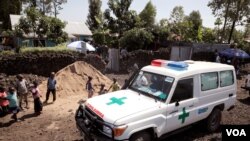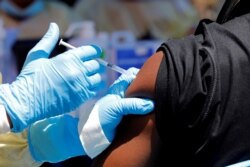The World Health Organization said Friday that the deadly Ebola virus had spread to new areas in eastern Democratic Republic of the Congo. The number of cases was 2,934, including 1,965 deaths, it said.
Since mid-June, the WHO has reported an average of 80 new Ebola cases every week. It said, though, that these numbers have been falling in recent weeks.
Michael Ryan, executive director of WHO’s Health Emergencies Program, said two new health zones, Mwenga in South Kivu and Pinga in North Kivu, had reported cases in the past week, and that the risk of further spread remained high.
"The geographic extension of the virus has increased while the intensity of transmission has reduced in that time,” he said. “So we are winning against the virus in the intense transmission areas, but still failing to prevent the further extension of the virus into other areas before the disease is properly extinguished."
Ryan noted progress in containing the disease was being made in some areas. He said some powerful tools were being put to good use in tackling the disease. He said a vaccine now is available that is protecting people from becoming infected, which wasn’t the case in previous outbreaks. Also, two new therapeutics are successfully saving the lives of people with Ebola who seek early treatment.
Community mistrust
But Ryan said pockets of community mistrust continued to hinder efforts to stop the epidemic. He said negative social media campaigns that have spread false information were creating difficulties in gaining community confidence.
He said, for instance, that some messages have said the vaccine is used to infect people, not protect them, and treatments are used to finish victims off. “And there are WhatsApp groups and many social media conversations that are going on at that level,” he said. “And populations, like in every country in the world, are exposed to both the positive and negative media around any intervention like this."
Ryan said WHO must be smarter, quicker and more effective in getting communities to hear its messages about pathways to good health. He said the way to counter bad information is not by blocking it, but by putting out good information. Then, he said, it is up to the communities to choose the messages they believe will best ensure their own future.










